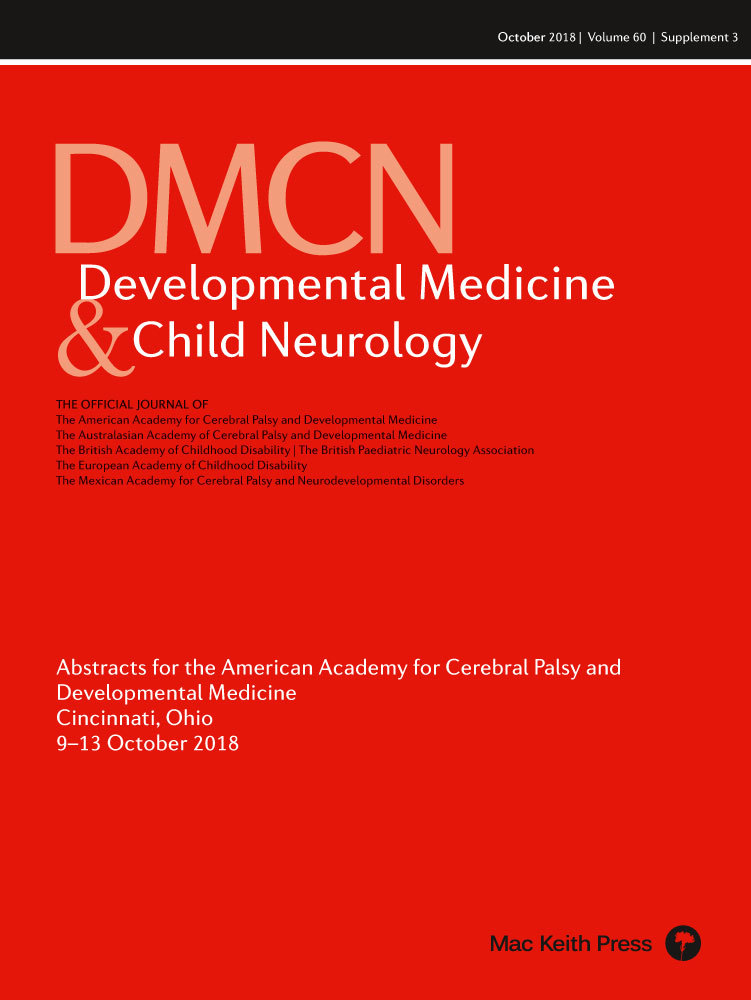Accelerometry for the early detection of motor deficits in children
SP42
C Hoyt
Washington University in St. Louis, St. Louis, MO, USA
Background and Objective(s): Cerebral Palsy (CP) is the most common cause of childhood disability. Early identification could ameliorate long-term outcomes. Current methods rely on parent report and brief clinical encounters, often resulting in delayed diagnosis. Objective measurement using wearable accelerometers can inform providers about real-world activity. The present study aims to provide a referent dataset to use accelerometry in the identification of motor deficits.
Study Design: This study used a prospective, observational cohort design.
Study Participants & Setting: Two cohorts of children 0–17 years were recruited for this study; typically developing (TD) and those with motor impairment associated with CP. Children with a history of autism spectrum disorder were excluded. For the typical cohort, a snowball sampling method and focused recruitment approach led to 156 children with equal distribution of age and sex and no history of motor delay being included in the analyses. Children were excluded if parents reported neurological impairment or any diagnoses with associated motor deficits. Twenty-five children with a confirmed diagnosis of CP were recruited from St. Louis Children's Hospital. Twenty had unilateral motor deficits classified as hemiparesis and 5 had other types of CP. Children were excluded if they had Botulinum Toxin therapy in the previous 3 months or had orthopedic surgery in the previous 6 months. For both cohorts, the majority identified as White and lived in married parents that with a college education or higher.
Materials/Methods: Using a prospective, observational cohort design; participants wore ActiGraph wGT3X accelerometers bilaterally on upper limbs (UL), just above the ulnar styloid for up to 100 hours in 25 hour increments. One-time use bracelets were used to maximize adherence. Parent report questionnaires confirmed typical development and the Melbourne Test of Unilateral Upper Limb Function quantified motor impairment.
Movement data were sampled at 30 Hz and processed using MATLAB Version 2015a. Accelerometry data was characterized by the total hours of activity, use ratio (UR), magnitude ratio and bilateral magnitude. For the TD cohort, descriptive statistics were calculated to summarize variables for each age year and unpaired t-tests were used to examine differences between groups classified as early (0–3 years), middle (4–10 years) and late childhood (11+ years).
Results: Among the TD cohort, participants 4–10 yrs. old had more hours of activity than younger and older children (t=−3.97, p<0.01; t=5.54, p<0.01). The youngest had a mean UR of 1 (SD=0.05), indicating equal use of both UL, which was higher than middle (=0.96, SD=0.05, t=−6.39, p<0.01) and late childhood ((=0.96, SD=0.07, t=−5.67, p<0.01). Children with hemiparesis had the lowest UR ((=0.72, SD=0.12), whereas the children with other types of CP had a similar UR to the TD (=0.92, SD=0.06; =0.97, SD=0.05). The UR was lower among those with hemiparesis than TD (t=382.2, p<0.001) with an optimal cutoff at 0.80 (AUC=0.93).
Conclusions/Significance: In this initial sample, TD children demonstrated a decline in UR in the first years of life as hand dominance evolves. These data provide a referent cohort for future studies and suggest that the UR can discriminate between those with unilateral impairment at very early ages while overall activity may be able to classify children with more global deficits. Our findings reveal that decreased use of affected UL may become more pronounced with age offering an exciting opportunity for intervention.




